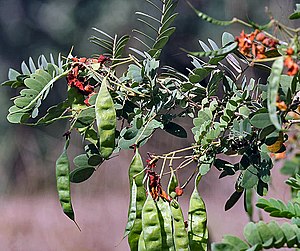Note: This is a project under development. The articles on this wiki are just being initiated and broadly incomplete. You can Help creating new pages.
Difference between revisions of "Senna auriculata - Avaram senna"
(Created page with "thumb|right|''Senna auriculata'', ''Avarike'' '''Senna auriculata''' is a legume t...") |
(No difference)
|
Revision as of 14:28, 17 January 2017
Senna auriculata is a legume tree in the subfamily Caesalpinioideae. It is commonly known by its local names matura tea tree, ranawara or avaram, (Kannada: ಆವರಿಕೆ āvarike, Telugu: తంగేడు taṃgēḍu, Tamil: ஆவாரை āvārai) or the English version avaram senna.
It occurs in the dry regions of India and Sri Lanka. It is common along the sea coast and the dry zone in Sri Lanka.
Description
Avaram senna is a much branched shrub with smooth cinnamon brown bark and closely pubescent brachlets.
The leaves are alternate, stipulate, paripinnate compound, very numerous, closely placed, rachis 8.8-12.5 cm long, narrowly furrowed, slender, pubescent, with an erect linear gland between the leaflets of each pair, leaflets 16-24, very shortly stalked 2-2.5 cm long 1-1.3 cm broad, slightly overlapping, oval oblong, obtuse, at both ends, mucronate, glabrous or minutely downy, dull green, paler beneath, stipules very large, reniform-rotund, produced at base on side of next petiole into a filliform point and persistent.
Its flowers are irregular, bisexual, bright yellow and large (nearly 5 cm across), the pedicels glabrous and 2.5 cm long. The racemes are few-flowered, short, erect, crowded in axils of upper leaves so as to form a large terminal inflorescence stamens barren; the ovary is superior, unilocular, with marginal ovules.
The fruit is a short legume, 7.5–11 cm long, 1.5 cm broad, oblong, obtuse, tipped with long style base, flat, thin, papery, undulately crimpled, pilose, pale brown. 12-20 seeds per fruit are carried each in its separate cavity.
Uses
- This plant is said to contain a cardiac glucoside (sennapicrin) and sap, leaves and bark yield anthraquinones, while the latter contains tannins.
- The root is used in decoctions against fevers, diabetes, diseases of urinary system and constipation. The leaves have laxative properties.
- The dried flowers and flower buds are used as a substitute for tea in case of diabetes patients.
- In Africa the bark and seeds are said to give relief in rheumatism, eye diseases, gonorrhea, diabetes and gout.
